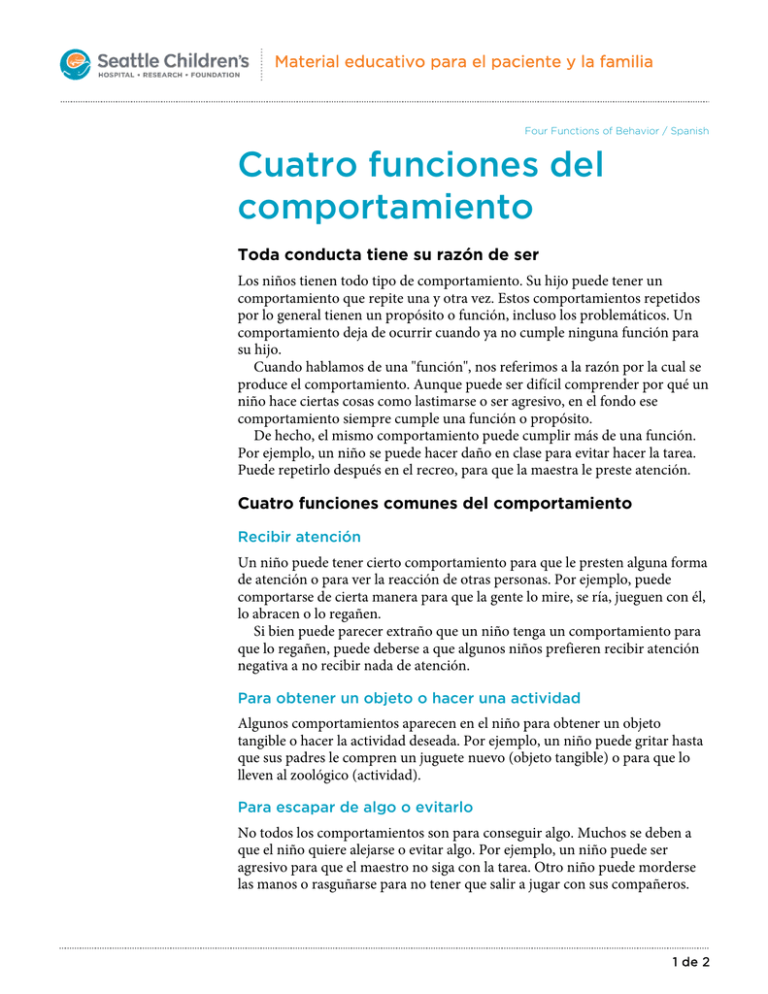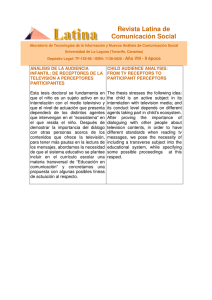PE1913S Four Functions of Behavior - Spanish
Anuncio

Material educativo para el paciente y la familia Four Functions of Behavior / Spanish Cuatro funciones del comportamiento Toda conducta tiene su razón de ser Los niños tienen todo tipo de comportamiento. Su hijo puede tener un comportamiento que repite una y otra vez. Estos comportamientos repetidos por lo general tienen un propósito o función, incluso los problemáticos. Un comportamiento deja de ocurrir cuando ya no cumple ninguna función para su hijo. Cuando hablamos de una "función", nos referimos a la razón por la cual se produce el comportamiento. Aunque puede ser difícil comprender por qué un niño hace ciertas cosas como lastimarse o ser agresivo, en el fondo ese comportamiento siempre cumple una función o propósito. De hecho, el mismo comportamiento puede cumplir más de una función. Por ejemplo, un niño se puede hacer daño en clase para evitar hacer la tarea. Puede repetirlo después en el recreo, para que la maestra le preste atención. Cuatro funciones comunes del comportamiento Recibir atención Un niño puede tener cierto comportamiento para que le presten alguna forma de atención o para ver la reacción de otras personas. Por ejemplo, puede comportarse de cierta manera para que la gente lo mire, se ría, jueguen con él, lo abracen o lo regañen. Si bien puede parecer extraño que un niño tenga un comportamiento para que lo regañen, puede deberse a que algunos niños prefieren recibir atención negativa a no recibir nada de atención. Para obtener un objeto o hacer una actividad Algunos comportamientos aparecen en el niño para obtener un objeto tangible o hacer la actividad deseada. Por ejemplo, un niño puede gritar hasta que sus padres le compren un juguete nuevo (objeto tangible) o para que lo lleven al zoológico (actividad). Para escapar de algo o evitarlo No todos los comportamientos son para conseguir algo. Muchos se deben a que el niño quiere alejarse o evitar algo. Por ejemplo, un niño puede ser agresivo para que el maestro no siga con la tarea. Otro niño puede morderse las manos o rasguñarse para no tener que salir a jugar con sus compañeros. 1 de 2 Cuatro funciones del comportamiento Para más información • Centro de Autismo 206-987-8080 • Consulte con el proveedor de atención médica de su hijo • www.seattlechildrens.org Estimulación sensorial El niño puede tener ciertos comportamientos que le hacen sentirse bien internamente y se denominan "autoestimulantes." La autoestimulación le da una sensación interna agradable o sirve para contrarrestar una sensación molesta, como el dolor. Por ejemplo, a un niño le puede gustar mecerse porque siente que es agradable. Otro niño se puede frotar la rodilla para aliviar el dolor después de un golpe. En ambos casos, los niños no están tratando de llamar la atención, de obtener un objeto tangible, ni de escapar de alguna exigencia o tarea. ¿Cuál es la ventaja de entender el propósito del comportamiento de mi niño? Servicio gratuito de interpretación: • Estando en el hospital, solicítelo con la enfermera de su niño. • Fuera del hospital, llame a la línea gratuita de interpretación 1-866-583-1527. Dígale al intérprete el nombre de la persona o la extensión que necesita. • Para personas sordas o con problemas de audición: 206-987-2280 (TTY). Saber la razón o función de la conducta problemática puede ayudarle a entender las necesidades de su niño. Esta información también es útil para idear un tratamiento para que su niño aprenda comportamientos alternativos (tal como dar una señal para pedir ayuda en lugar de golpear o gritar). También es útil compartirla con la guardería, la escuela y los terapeutas. • Cuando observe un comportamiento perjudicial en su hijo, piense cuál es su significado o función. • ¿Está tratando de escapar de una tarea o una situación, de conseguir algún objeto o hacer alguna actividad o lo hace cuando no se le presta atención? • Concéntrese en la conducta problemática que interfiere con la rutina diaria. Identificar la función de estas conductas puede ser muy importante para encontrar una terapia con objetivos específicos, para apoyarlo y que pueda lograr cambios en su comportamiento. Adaptado de “Functions of Behaviour” con autorización de Gavin Cosgrave de Educate Autism. www.educateautism.com Seattle Children’s ofrece servicio de interpretación gratuito para pacientes, familiares y representantes legales sordos, con problemas de audición o con inglés limitado. Seattle Children's tendrá disponible esta información en formatos alternativos bajo solicitud. Llame al Centro de Recursos para Familias al 206-987-2201. Esta información ha sido revisada por personal clínico de Seattle Children's. Sin embargo, como las necesidades de su niño son únicas, antes de actuar o depender de esta información, por favor consulte con el médico de su hijo. © 2014 Seattle Children’s, Seattle, Washington. Todos los derechos reservados. Centro de Autismo 5/14 Tr (jw/lv) PE 1913S 2 de 2 Patient and Family Education Four Functions of Behavior Behaviors occur for a reason Children engage in all kinds of behavior. Your child may have some behaviors they do again and again. These repeated behaviors often serve some purpose or function, even if they are disruptive. Unless a behavior serves some kind of function for your child, it won’t keep happening. When we say the “function” of behavior we mean the reason why the behavior occurs. While it can be hard to understand why a child does something such as hurt themselves or be aggressive, there is always an underlying function that the behavior serves for them. Behavior can serve more than one function. For example, a child might hurt themselves during class to get out of having to complete school work. Then they might also hurt themselves on the playground to get attention from the teachers. Four common functions of behavior To get attention A child may do a certain behavior to get some form of attention or a reaction from other people. For example, a child might engage in a behavior to get other people to look at them, laugh at them, play with, hug or scold them. While it may seem strange that a child would engage in a behavior to get scolded, it can occur because for some children it is better to get bad attention than none at all. To get an object or do an activity Some behaviors occur so the child can get a tangible item or gain access to a desired activity. For example a child may scream and shout until their parents buy them a new toy (tangible item) or bring them to the zoo (activity). To escape or avoid something Not all behaviors occur so the child can get something. Many behaviors occur because the child wants to get away or avoid something. For example, a child might become aggressive so the teacher stops doing school work with them. Another child may begin to bite their hands or scratch themselves to avoid having to go outside to play with classmates. 1 of 2 Four Functions of Behavior To Learn More • Autism Center 206-987-8080 • Ask your child’s healthcare provider • www.seattlechildrens.org Free Interpreter Services • In the hospital, ask your child’s nurse. • From outside the hospital, call the toll-free Family Interpreting Line 1-866-583-1527. Tell the interpreter the name or extension you need. • For Deaf and hard of hearing callers 206-987-2280 (TTY). Sensory stimulation Some behaviors a child does feel good to them internally and are called “selfsimulating.” Self-stimulation functions to give the child some form of internal sensation that is pleasing or to deal with a sensation that is uncomfortable such as pain. For example, a child might rock back and forth because it is enjoyable for them. Another child might rub their knee to sooth the pain after banging it. In both cases, these children do not engage in either behavior to get attention, any tangible items or to escape any demands placed on them. How can understanding the function of my child’s behavior help? Learning the function behind your child’s disruptive behaviors can help you understand your child’s needs. You can also use the information in a treatment plan to help your child learn an alternative behavior (such as signaling for help instead of hitting or yelling). It is also helpful information to share with your child’s day care, school and therapists. • When you watch your child doing an disruptive behavior, think about what the function might be. • Is your child trying to escape a task or a situation? Is it happening because your child wants to get a favorite item to activity? Does it happen when your child is not getting attention? • Focus on problem behaviors that interfere with day to day functioning. These may be the most important to find their function to help set therapy goals and support changes for your child’s behavior. Adapted from “Functions of Behaviour” with permission by Gavin Cosgrave from Educate Autism. www.educateautism.com Seattle Children’s offers interpreter services for Deaf, hard of hearing or non-English speaking patients, family members and legal representatives free of charge. Seattle Children’s will make this information available in alternate formats upon request. Call the Family Resource Center at 206-987-2201. This handout has been reviewed by clinical staff at Seattle Children’s. However, your child’s needs are unique. Before you act or rely upon this information, please talk with your child’s healthcare provider. © 2014 Seattle Children’s, Seattle, Washington. All rights reserved. Autism Center 5/14 PE1913 2 of 2
